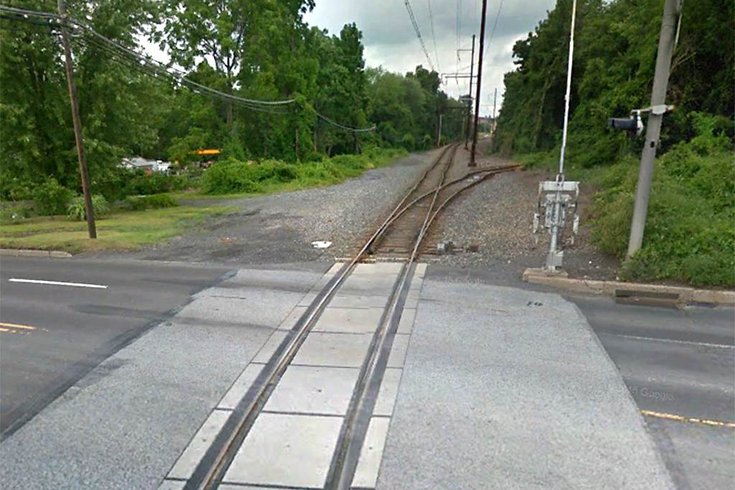
February 25, 2016
 Google/StreetView
Google/StreetView
A view – looking north from County Line Road – of the tracks along SEPTA's Warminster line. It will be the first Regional Rail line to be installed with Positive Train Control, a speed safety system.
UPDATE: Feb. 26, 2015
The Federal Railroad Administration completed its testing of the Postive Train Control system installed on SEPTA's Warminster Regional Rail line Thursday night. The first date that trains will operate using PTC is yet to be determined, but SEPTA spokesman Andrew Busch said it will not occur Monday.
"Basically, all indications are the tests were satisfactory," Busch wrote in an email on Friday. "We're now working with FRA to determine a start date for the Revenue Service Demonstration (the fancy name for having it active in regular passenger service) on the Warminster Line. It definitely will not happen on Monday, although that's not due to a problem, just the process of working through this with FRA."
• • •
A new, federally mandated safety system could be operational on SEPTA's Warminster Regional Rail line as soon as Monday, the agency said Thursday.
Over the next several nights, the Federal Railroad Administration will finish a series of tests on Positive Train Control, a system of speed control technology, on the Warminster line, the first of SEPTA's Regional Rail lines to get it, according to Jeffrey D. Knueppel, general manager of the transit agency.
Software upgrades will be uploaded this weekend to 110 rail cars needed to complete the Revenue Service Demonstration, which will be done during regular service operations.
"We're coming to the end of our work," Knueppel said. "We've done just about everything we can do to have the system ready."
Knueppel said the FRA has indicated its tests are going well. He said that PTC could be operational on Monday, but stressed the situation remains fluid. That's the earliest date possible, he said.
"The testing from all accounts, so far, is going well," Knueppel said. "What's not as clear is when the FRA will be satisfied and allow us to start operating on the Warminster line."
SEPTA then will begin rolling out PTC on all of its Regional Rail lines, a progression that could add the technology to a new line every couple of weeks. The technology automatically slows or halts trains exceeding speed limits, among other safety prevention measures.
"We do expect that once we get going it will be a progression that will continue at a decent pace," spokesman Andrew Busch said. "It's not going to be anything that's going to stretch into next year or anything like that."
SEPTA is installing the same technology – Advanced Civil Speed Enforcement System – as Amtrak. But it is the first commuter rail operator to utilize the ACSES technology, which serves as an overlay to Automated Train Control-equipped trackage. That combination meets FRA guidelines for a PTC system.
SEPTA opted to use ACSES, because it shares some railways with Amtrak, Knueppel said. Otherwise, the trains would have to use two systems, which Knueppel described as problematic. That's also why SEPTA spent $8 million to separate its trains from running on a stretch of CSX tracks.
The Amtrak derailment last May did not cause SEPTA to expedite its PTC process, Knueppel said. Amtrak train No. 188 was traveling 102 mph through a 50 mph zone, but automatic train control technology would have prevented the derailment. The crash killed eight passengers and injured more than 200 others.
SEPTA's Airport line reaches 79 mph and the West Trenton line tops out at 70 mph, Knueppel said. The other lines top out in the 60 mph range.
In addition to controlling train speeds, PTC also ensures trains adheres to train signals and follows safety restrictions in work zones and railroad crossings.
The Warminster line is the first to receive PTC because trains run on a single track, Knueppel said. He said the Fox Chase and Doylestown lines, which also run on a single track, also are high priorities.
"That's one of the biggest safety concerns – running two ways on a single track," Knueppel said.
PTC would have prevented a head-on collision between two SEPTA trains traveling on the Warminster line in 2006, Knueppel said. The trains hit at 15 mph, injuring 30 people.
"That's the type of thing that this system prevents," Knueppel said.
SEPTA has alerted passengers on the Warminster line that PTC soon will become operational, but they should not experience a noticeable difference.
"We've had SEPTA ambassadors out at stations on the line this week giving people literature about it," Busch said. "It's not necessarily something that people are going to notice in their travel. We just want to make them aware that we're doing this."
SEPTA has spent $328 million on efforts to install PTC across its rail system. In addition to installing ACSES as an overlay, SEPTA also needed to install ATC on some of its tracks.
SEPTA initially planned to have PTC operational by Dec. 31, 2015. But when Congress extended the federal deadline until 2018, the FRA required all commuter rail operators to resubmit their plans for approval, delaying SEPTA's process, Busch said.